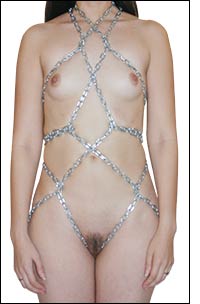

 You need not use rope to do shibari. Sometimes, it's more fun to use chain, and the look and feel of chain are completely different. Many people like the weight of chain, and as this picture shows, the harnesses that can be made with rope can be made with chain as well. You need not use rope to do shibari. Sometimes, it's more fun to use chain, and the look and feel of chain are completely different. Many people like the weight of chain, and as this picture shows, the harnesses that can be made with rope can be made with chain as well.
This section assumes you have already read the tutorial explaining how to make a basic shibari karada with rope. If you haven't read that yet, you should get over there! How to Make a Karada Out of Chain The idea behind making a karada or other tie with chain is essentially the same as making a rope harness, though there are a few potential "gotchas." The first time I made a karada with chain, it turned out to be more difficult than I expected it to be, because the chain does not slide like rope does. That's not a difficult problem to solve, but it does mean that some of the earlier steps have to be done a little bit differently.
The chain I'm using here is 30' long. As with the rope karada, you can use a longer piece of chain if you want to incorporate some other kind of tie into the karada as well. I don't use chain for doing frog ties or similar ties, because it's more difficult to remove chain quickly than it is to remove rope quickly if your partner becomes uncomfortable. Still, with a longer piece of chain, you can do things like place the karada on your partner, then wrap the ends of the chain around a post or other fixed upright object, chaining him or her to the post. So, assuming you've read the rope karada tutorial, let's get started! Once you've found the center of the rope, you'll slip it over the other person's head so that it hangs down the front of his or her body, just as you did with the rope harness. However, you can't simply twist it three times in the front like you did before, because the chain doesn't slide. So instead, you'll have to twist the chain and hold the twisted sections open to create the "diamonds" in the front, like you see here. (This is easiest to do if you either have your partner hold the chain, or have another person assisting you.) As with the rope, you'll bring the ends down between your partner's legs, then up behind your partner, around your partner's body, and through the section in front.
Keep doing this, same way you did with the rope, until you reach the top. In the picture below, after I've brought the chain around and through the top diamond, I then brought it over the shoulders rather than back around under the arms like I did with the rope harness. Because you can't easily tie chain, it's much simpler to use an openable chain link. (When you make a rope harness, you can bring the rope over the person's shoulders rather than under the person's arms, if you like.) The chain goes over the shoulders and then down your partner's back. Use an openable chain link to link the chain together behind your partner's neck, like you see in the picture here:
Almost done. Take the excess length of chain where it hangs behind your partner's back, and tuck it beneath the chain passing around your partner's body, like these pictures show. Slip an openable chain link through the place where all the chain comes together. If you use a 25' length of chain, you'll probably find that you're out of chain at this point. With the 30' length of chain I used in this demonstration, there's enough left to chain the person to a fixed object of your choice; alternately, you can leave it hanging as a kind of tail.
What you'll need
|
||||||||||||||||||||
 This site is part of Franklin Veaux's Sprawling Web Empire™
This site is part of Franklin Veaux's Sprawling Web Empire™